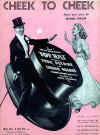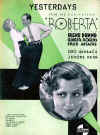History of Musical Film
1930s III - Astaire and Rogers
by John Kenrick
(Copyright 1996; revised 2020)
(The images below are thumbnails – click on them to see larger versions.)
RKO: Fred and Ginger
 Fred Astaire and Ginger Rogers are separated
by a Top Hat on the original sheet music cover for Irving Berlin's "Cheek to
Cheek."
Fred Astaire and Ginger Rogers are separated
by a Top Hat on the original sheet music cover for Irving Berlin's "Cheek to
Cheek."
In 1928, businessman Joseph P. Kennedy teamed up with RCA Radio and the Keith-Orpheum vaudeville theatre circuit to form Radio-Keith-Orpheum, usually referred to as RKO Pictures. Although often strapped for cash, the studio managed an ambitious creative range, creating the iconographic King Kong and the landmark drama Citizen Kane. It is perhaps appropriate that the first major Hollywood studio formed after the invention of sound should produce the first series of screen musicals to creatively integrate song, story and dance as story-telling tools -- all a full decade before Broadway saw a similar revolution begin with Oklahoma.
RKO's earliest musicals had been forgettable efforts until a lucky bit of support casting unexpectedly opened the way for change. Broadway veteran Fred Astaire made little headway in Hollywood until RKO cast him in the minor role of a band leader in Flying Down To Rio (1933). When offered the choice of several starlets as a dance partner, he chose Ginger Rogers, who he had met when he choreographed a routine for her in the 1930 Broadway production of Girl Crazy.
Through most of Flying Down to Rio, top-billed stars Dolores Del Rio and Gene Raymond slog through a tedious love plot (and several equally tedious songs) while Astaire and Rogers provide occasional wisecracks. Then during "The Carioca," Fred and Ginger step on to a nightclub dance floor and dance while linking foreheads. Suddenly, their wholesome charm had unmistakably sexual undertones, turning the number into the highlight of the film. Flying Down to Rio managed just under half a million dollars in profit -- which, with the Great Depression at its worst, was enough to get the attention of RKO executives.
Rio had a surprising impact on viewers. Decades later, director Stanley Donen described his reaction this way --
"I was nine, and I'd never seen anything like it in my life. I'm not sure I have since. It was as if something had exploded inside me. . . I was mesmerized. I could not stop watching Fred Astaire dance. I went back to the theatre every day while the picture was playing. I must've seen it at least twenty times. Fred Astaire was so graceful. It was as if he were connected to the music. He led it and he interpreted it, and he made it look so effortless. He performed as though he were absolutely without gravity."
- as quoted by Stephen M. Silverman in Dancing on the Ceiling: Stanley Donen and His Movies. (New York: Alfred A. Knopf, 1996), pp. 11-13.
Producer Pandro S. Berman persuaded the studio to showcase Astaire and Rogers in a star vehicle of their own. In The Gay Divorcee (1934), they danced and romanced, inventing what became their standard formula – in a high society setting, a charming playboy and a sweet girl with spunk get into a tangle of mistaken identities, fall in love on the dance floor (to something like Cole Porter’s "Night and Day"), resolve their misunderstandings in the nick of time, and foxtrot their way to a black and white "happily ever after" ending.
This film was based on the stage musical Gay Divorce, but the Hays office demanded a change of title. Under Hollywood's Production Code, it was acceptable to suggest a divorced person was "gay" (meaning "happy"), but a film couldn't say that a divorce was happy! Amid the glamorous surroundings and witty banter, Astaire and Rogers come across as likeable Americans, "just like us" – or just like the folks most people wished they could be. Lavishly produced, Gay Divorcee managed to make a slightly larger profit than it predecessor.
The same formula was carefully repeated in Top Hat (1935), which embodies RKO's Astaire-Rogers series at its best. There is a a variation of the "mistaken identities" plot with stylish comic support from Edward Everett Horton, Eric Blore and Helen Broderick, and a solid-gold score by Irving Berlin. "Isn’t This a Lovely Day To Be Caught In The Rain," "No Strings," the title tune and the unforgettable "Cheek to Cheek" are deftly integrated into a story of mistaken identities set in an eye-popping black and white art deco vision of Venice. The dialogue is breezy and clever, and the atmosphere one of sophisticated delight. It is still hard to resist this cinematic cocktail. Produced for a then hefty $625,000, Top Hat grossed $3.2 million in its initial release -- the Astaire-Rogers franchise was riding high.
A popular quote attributed to actress Katherine Hepburn claims that "Fred gave Ginger class, while she gave him sex (appeal)." The fact is that both Astaire and Rogers already had each of those qualities. It was the indefinable connection between their screen personas that made thus duo so irresistible.
The Astaire-Rogers Formula
 The original sheet music cover
for "Yesterdays," a hit song in Roberta (1935),
depicts Astaire & Rogers as well as co-star Irene Dunne.
Now remembered as a dramatic actress, Dunne had a fine soprano
voice and starred in numerous screen musicals.
The original sheet music cover
for "Yesterdays," a hit song in Roberta (1935),
depicts Astaire & Rogers as well as co-star Irene Dunne.
Now remembered as a dramatic actress, Dunne had a fine soprano
voice and starred in numerous screen musicals.
During the golden age of the Hollywood studio system, the goal for most studios was to find stars, then to create films that showcased their particular talents. Once the public embraced the Astaire and Rogers "mistaken identities" formula, RKO relied on variations of that plot for Astaire and Rogers in five more films, most directed Mark Sandrich. Choreographed primarily by Astaire and his associate Hermes Pan, these were the first musicals (on stage or screen) to make substantial use of integrated dialogue, song and dance to develop character and tell a story. After the rather forgettable songs in Flying Down to Rio, the scores were provided by top composers.
Roberta (1935) included Jerome Kern's "I’ll Be Hard To Handle"
Follow The Fleet (1936) had Irving Berlin's "Let's Face the Music and Dance"
Swing Time (1936) boasted Jerome Kern's "The Way You Look Tonight"
Shall We Dance (1937) offered George and Ira Gershwin's "Let’s Call the Whole Thing Off" and "They Can’t Take That Away From Me"
Carefree (1938) included Berlin's "Change Partners"
Whenever the formulaic mistaken identity plots wear thin, Astaire and Rogers start dancing and joy reigns again on screen. Never more than cordial colleagues in real life, their dance numbers exude a playful yet seductive passion. Astaire had any number of accomplished dance partners over the years, but the chemistry he enjoyed with Rogers was unique. Both Astaire and Rogers were workaholics, He put in an average of 350 hours rehearsing the dances for every film, and both were always willing to do as many takes as it took to get a number right. While filming Follow the Fleet, they reputedly interrupted retakes of one routine just long enough to pour blood out of their dance shoes and allow studio medics to bandage their feet before filming several more takes.
In time, the formula wore out its appeal, and both Astaire and Rogers became anxious to move on with their individual careers. So they ended their RKO partnership with The Story of Vernon and Irene Castle (1939), which dropped the formula to pay a stylish and heartfelt tribute to a real-life ballroom dance team from the pre-World War I era. To the studio's surprise, the public didn't give a hoot about the missing formula -- they lined up one more time to see Fred and Ginger dance.
Later Years
In the years following the RKO series, Astaire starred in dance musicals for various studios while Rogers sought to prove herself as a dramatic actress. She won an Academy Award as Best Actress for Kitty Foyle (1940). (Author's note: Garland, Kelly and Astaire never received acting Oscars, but Rogers got one? Such is the importance of timing.) When an ailing Judy Garland dropped out of MGM's The Barkleys of Broadway (1949), Astaire and Rogers were re-united one final time. The old team's chemistry remained delightful in this tale of a theatrical husband and wife.
Astaire's later screen musicals included Royal Wedding (1951), The Band Wagon (1953), Funny Face (1957) and Finian’s Rainbow (1968). He also starred in a series of acclaimed dance specials for television. He was nominated for an Academy Award for a dramatic role in The Towering Inferno (1974), and made his final musical screen appearance dancing with Gene Kelly in That's Entertainment II (1976). Astaire consistently spoke well of Rogers, complimenting her professionalism and dedication.
Rogers filmed mostly forgettable dramas, limiting her musical efforts to a few unsuccessful stage projects. In interviews, she often downplayed the importance of Astaire in her career. When Rogers died, preactically every newspaper and television newscast in the world carried pictures of her – dancing with Astaire. The image of Astaire and Rogers dancing their hearts out is one of the definitive cultural icons of the 20th Century, a reminder that a violent age also had a sense of music, fun, and sheer style that nothing could snuff out.
"In dance by (this) couple, we see our world and what it is possible to make of its spaces – in the light of such movements we can find that our earthbound nature is made acceptable, even delicious."
- Edward Gallafent, Astaire and Rogers (New York: Columbia University Press, 2000), p. 224.
RKO was hardly the only game in town. Throughout the 1930s, musicals were percolating at every major Hollywood studio . . .
